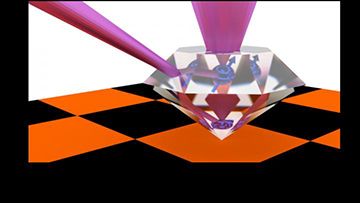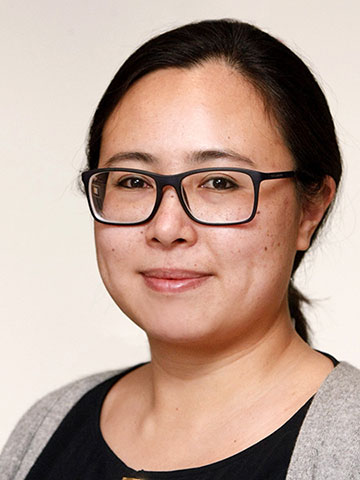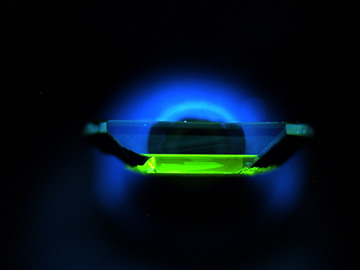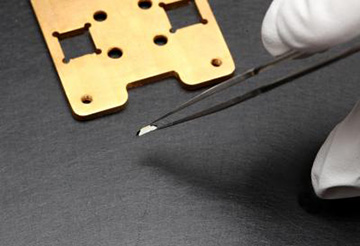
A newly developed color center in diamonds could be capable of acting as a quantum repeater, storing entanglement information from photons in electron spins and re-transmitting the information as photons in future secure quantum communications networks. [Image: Courtesy of Paul Stevenson, postdoctoral research associate, Princeton University]
A key enabler of future quantum communications networks would be some sort of quantum repeater, a device that can briefly store and re-transmit a quantum state to keep it alive along lengthy expanses of optical fiber. But voicing the need for quantum repeaters has proved considerably easier than finding a physical system that can do the job.
Now, researchers led by OSA member Nathalie de Leon at Princeton University, USA, have put a new candidate quantum repeater platform on the table: diamond crystal defects known as neutral silicon vacancy (SV0) centers (Science, doi: 10.1126/science.aao0290). The research team found that these centers, which the group fashioned through a neat piece of materials engineering, can efficiently transfer quantum entanglement information from photons to electrons and back again. And SV0 centers can keep the quantum state alive for more than just a few nanoseconds—a key requirement for a practical quantum repeater.
Dealing with distance
In quantum communication and encryption schemes like quantum key distribution (QKD), photons carry quantum information, such as entanglement, from end to end; any eavesdropping on the communications channel destroys the quantum state and can thus be detected. Running such a scheme in a typical fiber-based communication system breaks down, however, because of the exponential loss of photons with distance along a length of fiber.
That has made quantum networks impractical for runs even of as low as a few hundred kilometers—“not very scalable,” says de Leon, “in terms of actually building up a quantum network on the ground.” One alternative under active development is running long quantum-encrypted connections via laser links between Earth-orbiting satellites, with ground-based fiber used only for the relatively short-run, metropolitan part of the network. Such systems have seen considerable progress lately, but still face significant technical challenges (see “Satellite-based QKD,” OPN, February 2018).

Nathalie de Leon. [Image: Princeton University]
Another alternative is to create a quantum repeater, analogous to the classical repeaters used to regenerate optical signals in the current fiber communications system. Under a quantum repeater architecture, de Leon explains, small quantum memory units are distributed at various points along a lengthier run of fiber, dividing the run into short segments. Photons carrying entanglement information pass through the fiber to the repeater and transfer the entanglement information to, for example, the spin state of the electrons in the repeater material.
The spin state can later be re-transmitted in another photon and sent down the line to the next repeater, with the delicate entanglement information preserved. “So now you have these memories that are entangled over very long distances,” says de Leon, “and you can use this entanglement at the end as a resource for doing quantum communications.”
Strong but sensitive
A big hurdle for creating quantum repeaters lies in finding the right material for them. One promising candidate that has emerged in recent years has been so-called color centers in diamond. These are small crystal defects where another element has substituted for carbon in the diamond crystal lattice.
The best known of these color centers are negatively charged nitrogen vacancy (NV–) centers, where a nitrogen atom and a lattice vacancy act as the understudies for the usual carbon atom. The electron spin states in NV– centers are frequently cited candidates for quantum bits (qubits) in future quantum computing. That’s because the centers are unusually adept at hanging onto quantum spin information, with coherence times of a second or more.
But as quantum repeater candidates, NV– centers have an Achilles’ heel: their optical properties. From an optical perspective, de Leon notes, these color centers are almost “pathologically sensitive” to their environment. That means that NV– centers are a poor choice for actually distributing entanglement along a network, as transferring quantum information from the photon to the electron spin becomes a dicey proposition. “If you have any fluctuating charges in the center, even at the parts-per-billion level, then the color of the photon rapidly switches in time, which is a real killer for these kinds of applications,” she says.
The benefits of neutrality
De Leon and her team wanted to see if they could engineer a new color center that would maintain the long coherence times of NV– centers, but sport better optical properties. As a starting point, they looked at another kind of color center, negatively charged silicon vacancy (SV–) centers, in which silicon, rather than nitrogen, substitutes for carbon in the diamond crystal site.
In some ways, SV– centers have the opposite problem of NV– centers. The specific symmetry characteristics of SV– centers give them excellent, stable optical properties, despite their negative charge. But their electron configuration turns out to be extremely sensitive to dephasing from phonons (quanta of vibrational energy). That leads to spin coherence times of a measly 38 ns, even at frigid liquid-helium temperatures of 4.5 K.

Optical microscope image of the layered sample grown by Element Six. [Image: Brendon Rose]
The researchers reasoned that, by taking the negative charge out of the equation, they might be able to push the silicon vacancy centers back toward the longer coherence times of NV– centers, yet still hang onto the good optical properties of the SV– centers. To do so, the Princeton researchers worked with the U.K.-based industrial-diamond firm Element Six to engineer diamonds hosting charge-neutral, SV0 centers.
Layer by layer
The process begins by using microwave plasma-enhanced chemical vapor deposition to grow the diamond host, layer by layer. As the host is being grown, it is doped at progressively higher concentrations with boron atoms, to crowd out impurities and background defects that could introduce charges, and silicon atoms to create the actual vacancy centers. A final heating step drives off remaining impurities.
This delicate materials engineering produced a layered diamond containing a new kind of charge-neutral color center, SV0. The team’s tests of the material suggested that the SV0 centers recaptured the long, 1-second coherence time of the NV– centers. Yet the new color center also retained the strong optical properties of the SV– centers, such as narrow linewidth and a very low sensitivity of photon frequency to electric-field noise. The upshot: a color center that can play equally well with photons and electron spin—and, thus, a potentially good platform for a quantum repeater.
Wavelength conversion needed

A diamond sample containing SV0 centers. [Image: Frank Wojciechowski for Princeton University]
Even with that promising new platform, de Leon stresses, actually getting to a practical quantum repeater will require considerably more work. One big hurdle lies in the operating wavelength of the SV0 centers, which resides far outside of the optical telecom band. Because of signal attenuation, she explains, “you pay a huge penalty for being anywhere but 1.55 microns.” Resolving that problem will require single-photon wavelength conversion techniques that are still being developed, and on which she says her team is actively working under a DARPA Young Faculty Award.
Another focus for the lab, she says, will be investigating the fine structure and detailed physics of the SV0 centers, and how to integrate the diamond centers into specific device architectures employing other materials.
All of this could take a while, de Leon acknowledges. Sussing out the fundmental properties of NV– centers, she points out, has been a decade-long process. “Our bet is that we can move a lot faster, because we know what we’re looking for—a lot of people have laid out the map for how you go about characterizing these things,” she says. “But it’s still very early days.”
